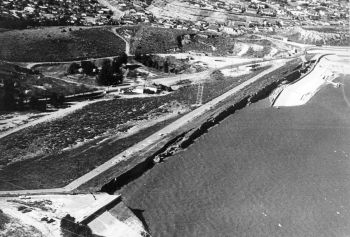Stability During an Earthquake

|
| Aerial view of the Lower Van Norman Dam after significant earthquake damage.
(Image Source: Wikimedia) |
As earthquakes pose a significant threat to infrastructure, dams must be designed to withstand seismic forces, and their construction and operation must account for earthquake loading to ensure the safety of nearby communities and the integrity of the structure.
The first step in assessing earthquake loading for dams is to understand the seismic hazards of the region. Engineers must study local earthquake records, geological surveys, and tectonic activity data. A seismic hazard analysis determines the maximum ground motions the dam might experience during an earthquake, allowing engineers to design dams that can withstand the anticipated seismic forces.
Based on the seismic hazard analysis, design criteria for the dam are established that define the level of ground shaking the dam should be designed to withstand. Factors such as the dam's location, geology, importance, and downstream consequences are considered when determining the design parameters. The seismic design criteria specify the expected level of ground motion in the case of a seismic event, the factors for safety, and the design stipulations that must be followed during the dam's construction.
Once the seismic design criteria are established, engineers conduct seismic analysis and design for the dam itself. They evaluate the dynamic response of the dam and its foundation to an earthquake’s ground motions. Using sophisticated computer models and numerical simulations, the dam’s behavior can be assessed under seismic loading. Based on the dam’s strength, stability, and deformations that it experiences during an earthquake, engineers design appropriate measures to reinforce the dam and enhance its seismic resistance.
In many cases, existing dams do not meet the required seismic design criteria. These dams require retrofitting and upgrading measures. To strengthen the dam and its foundation and to improve its seismic performance. This may include adding additional reinforcement, improving foundation stability, or modifying spillway and outlet structures. Upgrading involves assessing the dam's existing gates, valves, and monitoring systems to ensure they can withstand seismic forces.
